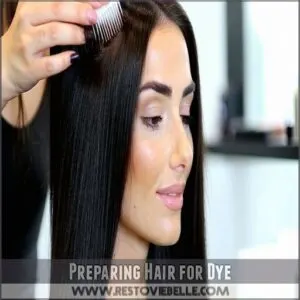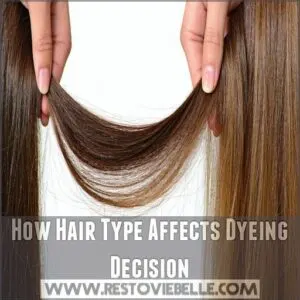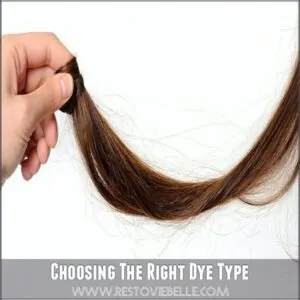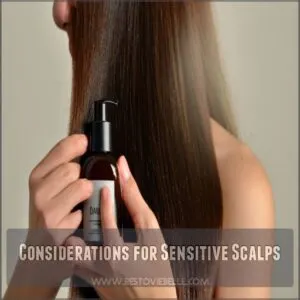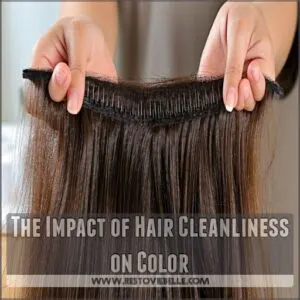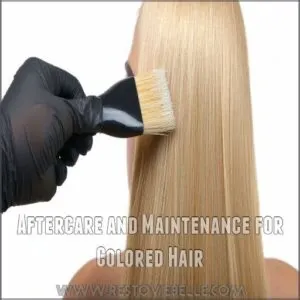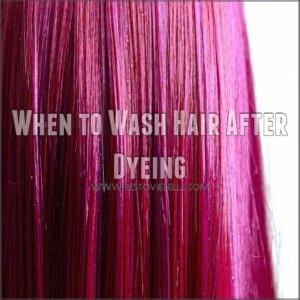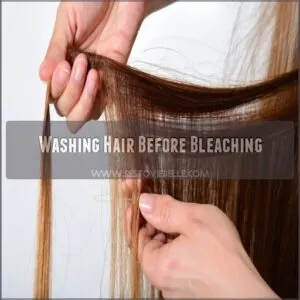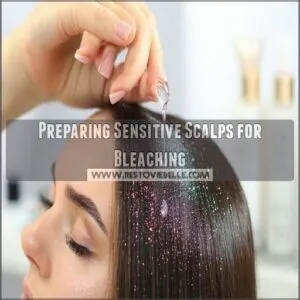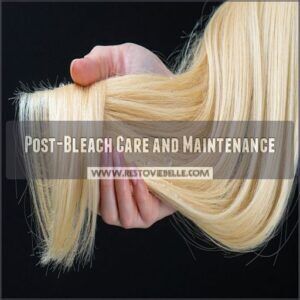This site is supported by our readers. We may earn a commission, at no cost to you, if you purchase through links.
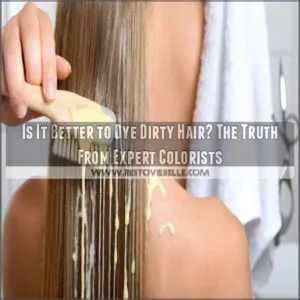 Contrary to popular belief, it’s not better to dye dirty hair.
Contrary to popular belief, it’s not better to dye dirty hair.
You’ll want to wash your hair 24-48 hours before coloring – just enough time for natural oils to return without buildup getting in the way.
Think of it like painting a wall: you wouldn’t slather paint over dirt and grime, right?
Clean hair allows the dye to penetrate evenly and create that gorgeous color you’re after.
While some stylists suggest dirty hair protects your scalp, excessive oil can actually block the dye from working its magic.
Your ideal sweet spot depends on your hair type and the dye you’re using.
Table Of Contents
- Key Takeaways
- Preparing Hair for Dye
- Is Dirty Hair Better for Dyeing
- How Hair Type Affects Dyeing Decision
- Choosing The Right Dye Type
- Considerations for Sensitive Scalps
- The Impact of Hair Cleanliness on Color
- Aftercare and Maintenance for Colored Hair
- When to Wash Hair After Dyeing
- Special Considerations for Bleaching
- Tips for a Successful Dye Job
- Frequently Asked Questions (FAQs)
- Is it better to dye your hair dirty or clean?
- Is dirty hair a good choice for hair color?
- Does hair color stick if your hair is dirty?
- Does dirty hair make the color process faster?
- Should I wash my hair before or after dyeing?
- Should I get a professional to dye my hair?
- Should you wash your hair before coloring?
- How many days dirty should my hair be when I dye it?
- Can hair be too greasy to dye?
- What not to do before dying hair?
- Can conditioner affect hair dye absorption?
- Does swimming pool chlorine impact dye results?
- How does hard water affect hair coloring?
- Should you brush hair before applying dye?
- Do heat styling tools affect dye application?
- Conclusion
Key Takeaways
- You’ll get the best results by washing your hair 24-48 hours before dyeing, allowing natural oils to return while avoiding product buildup.
- Your hair shouldn’t be too clean or too dirty – those natural oils help protect your scalp during coloring, but excessive buildup blocks dye from penetrating properly.
- You’ll want to wait at least 72 hours after dyeing before washing your hair again to let the color fully penetrate and set.
- Your hair type matters – if you’ve got oily hair, wash closer to the 24-hour mark, while those with dry or sensitive scalps should lean toward the 48-hour window.
Preparing Hair for Dye
You’ve probably wondered if you should wash your hair before dyeing it, and the answer isn’t as simple as you’d think.
Dyeing your hair requires finding the sweet spot between squeaky clean and naturally oily,
which usually means washing your hair about 24 hours before your dye job.
Hair Cleanliness and Color Penetration
The age-old question of whether to wash your hair before dyeing isn’t as straightforward as you might think.
Clean hair helps color penetrate evenly through your strands, especially for permanent dyes.
However, washing your hair too close to dyeing can strip it of its natural oils, which helps with dye absorption.
But here’s the twist: super-clean hair can actually make it harder for some dyes to grip.
The key is finding that sweet spot where your hair’s clean enough for good coverage, but not stripped bare.
Natural Oils as a Protective Barrier
Natural oils act like your hair’s built-in shield, protecting your scalp and strands during the dyeing process.
You’ve probably noticed these oils make your hair look a bit greasy after a day or two – that’s actually a good thing!
This protective layer helps prevent scalp irritation and reduces potential damage from harsh dye chemicals.
Think of it as your hair’s personal bodyguard.
Effects of Oil Buildup on Dye Penetration
While natural oils protect your scalp, too much buildup can block hair dye from working its magic. Here’s what happens when you’ve got excess oil:
- Your hair’s cuticles get clogged, preventing dye from penetrating deeply
- Color might look patchy or uneven in oilier sections
- Some areas could end up lighter than others
- You’ll likely need more dye to achieve your desired shade
That’s why timing your wash just right matters for perfect color results.
Is Dirty Hair Better for Dyeing
You’ve probably heard conflicting advice about dyeing dirty versus clean hair.
Here’s the truth: slightly dirty hair (1-2 days unwashed) often takes color better than freshly washed locks.
Those natural oils act like a protective barrier for your scalp, reducing irritation during the dyeing process.
But don’t let your hair get too grimy – excessive oil buildup can actually block dye from penetrating properly.
Think of it like trying to paint a wall that’s covered in dust – the color won’t stick right.
Most colorists recommend washing your hair 24-48 hours before your dye job.
For sensitive scalps, those natural oils are especially helpful.
They create a buffer between harsh chemicals and your skin, making the whole process more comfortable.
Plus, you won’t strip away protective oils right before applying potentially irritating dyes.
Remember: "dirty" doesn’t mean weeks of buildup – just skip that wash the day of dyeing.
How Hair Type Affects Dyeing Decision
Your hair type is the secret decoder ring to solving the dirty-or-clean dyeing debate, and what works for your bestie’s silky strands might be a total flop for your lovely locks.
Whether you’ve got hair that’s oily enough to fry an egg or dry as the Sahara, you’ll need a different game plan to get that perfect color you’re dreaming of.
Oily Hair and Color Application
Dealing with oily hair can make color application tricky.
When your scalp produces excess oil, it creates a barrier that prevents hair dye from penetrating evenly.
Think of it like trying to paint a wall that’s covered in grease – the color just won’t stick right.
For the best results, wash your hair 24 hours before dyeing to remove buildup while maintaining just enough natural protection.
Dry Hair and Natural Oil Preservation
Dry hair can actually be your secret weapon for dyeing.
Your natural oils act like a protective shield for your scalp and strands, making the dyeing process gentler.
If you’ve got dry or damaged hair, skipping that pre-dye wash might be your best move.
Think of those natural oils as nature’s conditioning treatment – they’ll help minimize irritation and keep your color looking vibrant.
Balancing Cleanliness and Moisture
Finding the sweet spot between clean and moisturized hair before dyeing isn’t rocket science.
Your natural oils serve as a protective shield, but too much buildup can block color absorption.
Skipping washes prior to a bleach session can also help prevent damage as dirty hair protects against irritation.
Here’s what works for most people:
- Wash hair 24-48 hours before dyeing
- Use a gentle, sulfate-free shampoo to avoid stripping
- Skip conditioner on the day of dyeing to help color penetrate better
Remember: Balance is key – you want hair that’s clean enough for the dye to work but not stripped bare.
Choosing The Right Dye Type
You’re about to make a big change to your hair, and picking the right dye type can mean the difference between "oops" and "wow."
Whether you’re going for permanent, semi-permanent, or demi-permanent color, your hair’s cleanliness plays a key role in how well the dye will work its magic.
Permanent Dyes and Clean Hair
Everyone wants their permanent hair color to last, and here’s the scoop: clean hair is your best friend for permanent dyes.
You’ll want to wash your hair 24 hours before coloring to remove product buildup while letting some natural oils return.
This sweet spot helps the dye penetrate evenly and protects your scalp, giving you that vibrant, long-lasting color you’re after.
Semi-Permanent Dyes and Slightly Dirty Hair
For semi-permanent dyes, slightly dirty hair can actually work in your favor.
Your natural oils create a protective barrier that helps the color stick around longer.
Here’s why many colorists prefer working with second-day hair:
- Your scalp’s less likely to get irritated during the dyeing process
- Natural oils help distribute the color more evenly
- The dye grips better to slightly dirty strands
Demi-Permanent Dyes and Hair Porosity
Your hair’s porosity plays a huge role in how demi-permanent dyes work their magic.
Think of your strands like a sponge – low porosity hair needs a bit more prep to open up those cuticles, while high porosity hair drinks up color fast.
You’ll want to balance your hair’s natural absorption rate with the right timing.
Testing your hair’s porosity beforehand and following a pre-coloring hair care routine, such as washing and conditioning, helps nail that perfect color every time.
Considerations for Sensitive Scalps
If you’ve got a sensitive scalp that feels like it’s staging a protest every time you color your hair, you’re not alone.
Your natural oils can actually be your best friends here, acting as a protective barrier between your tender scalp and those hair dye chemicals.
Benefits of Dyeing Slightly Dirty Hair
Slightly dirty hair creates a natural protective barrier that safeguards your sensitive scalp during the dyeing process.
These natural oils act like a shield, reducing potential irritation and preventing the dye from directly contacting your scalp.
You can also consider using a hair dye barrier to further minimize any potential discomfort.
Plus, second-day hair actually helps the color grip better to your strands, leading to more even coverage and longer-lasting results.
Think of it as your hair’s built-in insurance policy.
Risks of Dyeing Clean Hair on Sensitive Scalps
Dyeing freshly washed hair can spell trouble for sensitive scalps.
Clean hair strips away protective natural oils, leaving your scalp exposed to harsh chemicals like ammonia and peroxide.
You’re more likely to experience burning, itching, and redness during the coloring process.
The absence of that natural barrier also means the dye might penetrate too quickly, leading to uneven results and potential scalp irritation.
Pre-Dye Treatments for Sensitive Scalps
A sensitive scalp doesn’t mean you can’t rock a new hair color.
Start with a patch test 48 hours before dyeing to avoid any surprise reactions, taking into account that people with sensitive skin are more prone to scalp sensitivity.
Apply a pre-dye scalp mask with soothing ingredients like aloe vera or chamomile tea.
If you’re extra sensitive, try mixing a few drops of jojoba oil into your regular conditioner and applying it the night before – it’ll create a protective barrier without interfering with the dye.
The Impact of Hair Cleanliness on Color
You might think a squeaky-clean canvas is best for hair dye, but the connection between hair cleanliness and color results isn’t that simple.
Your hair’s natural oils can actually work in your favor when you’re coloring, acting like a protective barrier that helps prevent scalp irritation while still allowing the dye to work its magic.
How Clean Hair Affects Color Vibrancy
Three key factors make clean hair the perfect canvas for vibrant color: proper cuticle exposure, even dye distribution, and best color penetration.
When your hair’s free from buildup, the dye can work its magic more effectively.
- Fresh strands allow color molecules to penetrate deeper
- Clean hair helps achieve even color distribution from root to tip
- Product-free hair helps prevent patchy results
- Open cuticles absorb color more readily
- Proper preparation leads to truer, more vivid results
How Dirty Hair Affects Color Fade
Product buildup and excess oil can create a barrier that prevents hair dye from properly bonding, leading to patchy results and faster color fade.
Here’s what you need to know about dirty hair and color longevity:
| Hair Condition | Impact on Color | Fade Rate |
|---|---|---|
| Very Oily | Uneven Coverage | Fast |
| Moderately Clean | Best Penetration | Slow |
| Product Heavy | Poor Absorption | Medium |
Think of it like painting a wall – you wouldn’t paint over dirt and expect the color to last!
Balancing Color and Hair Health
While dirty hair might hold color better, you’ll want to strike a sweet spot between protection and proper dye absorption.
Think of it like painting a wall – you need a clean canvas, but not one that’s stripped bare.
Your best bet is washing hair 24-48 hours before dyeing. This gives your scalp’s natural oils time to build up while keeping your strands ready for color.
Aftercare and Maintenance for Colored Hair
You’ve nailed the perfect hair color, and now it’s time to keep that gorgeous shade looking fresh and vibrant.
Let’s explore how you can protect your investment with the right hair care routine that won’t send your color swirling down the drain.
Using Color-Safe Shampoo and Conditioner
After investing in your dream hair color, you’ll want to protect it with the right products.
To find the perfect match for your locks, check out recommendations for the best color safe conditioner.
Color-safe shampoos and conditioners are specially formulated to lock in dye molecules and prevent fading.
Look for sulfate-free options that won’t strip your color, and consider purple-toned products if you’re rocking blonde or silver shades.
Your regular drugstore shampoo might be great, but it could be secretly sabotaging your color investment.
Washing and Conditioning Frequency
Your freshly dyed locks need a specific washing schedule to keep that color looking fab.
To make sure the color lasts, wait at least two days before washing your hair, allowing the dye to fully penetrate the cuticle and adhere to the cortex for longer-lasting results using the right shampoo timing techniques.
You’ll want to limit washing to just 1-3 times per week using lukewarm water – hot water’s a big no-no as it opens up those hair cuticles and lets the color escape.
When you do wash, stick to a color-safe shampoo and skip daily washing to prevent your investment from literally going down the drain.
Maintaining Color and Moisture
Regular washing sets the stage for keeping that fresh color vibrant, but maintaining moisture is where the magic happens.
Think of your newly colored hair like a thirsty plant – to prevent color fading and maintain vibrancy, using sulfate-free shampoos and conditioners as part of your hair care routine after dyeing is essential. It needs consistent care to thrive.
- Mix a color-safe deep conditioning mask with a few drops of argan oil for an intensive moisture boost
- Apply a leave-in conditioner to damp hair, focusing on the ends
- Sleep on a silk pillowcase to prevent color-fade and moisture loss
When to Wash Hair After Dyeing
You’ve just transformed your hair with a fresh new color, and now you’re itching to hop in the shower.
Before you reach for that shampoo bottle, let’s talk about why timing your first post-dye wash is key for keeping your color vibrant and beautiful.
Waiting Period for Optimal Color Penetration
Patience pays off when it comes to fresh hair color.
The magic happens during those important 72 hours after dyeing, as color molecules fully penetrate your strands.
For the best results, it’s recommended to wait at least 48 hours before washing your hair after coloring, allowing the color molecules to set properly.
Think of it like letting paint dry – you wouldn’t touch a freshly painted wall, right?
Your hair cuticles need this time to seal in that gorgeous new shade, ensuring the color molecules lock in place for lasting vibrancy.
Risks of Washing Hair Too Soon
The first 72 hours after dyeing your hair are important – rushing to wash it can spell disaster.
When you shampoo too soon, you’re basically showing your fresh color the exit door.
The hair cuticle needs time to seal completely, and early washing can lead to uneven patches, dull spots, and faster fading.
Think of it like opening the oven too soon – your perfect results need time to set.
Tips for Maintaining Color Longevity
Smart color maintenance starts right after you’ve rocked your new shade. You’ll want to wait at least 72 hours before washing your hair – think of it as letting your color marinate to perfection.
- Use lukewarm water only – hot showers are your color’s worst enemy
- Switch to color-safe products that’ll keep your shade vibrant
- Deep condition weekly to prevent color fade
- Skip heat styling for the first week post-dye
- Try color-depositing masks to refresh your shade between sessions
Special Considerations for Bleaching
If you’re planning to bleach your hair, you’ll need to follow a different rule book than regular hair dye.
Bleaching your hair requires a clean slate, so you’ll want to shampoo your hair the day before bleaching to remove any buildup that could prevent the bleach from lifting evenly.
Washing Hair Before Bleaching
Before bleaching, you’ll want your hair clean but not squeaky clean.
Wash your hair 24-48 hours before the bleaching process to remove buildup while maintaining some natural oils.
This sweet spot helps the bleach work effectively without irritating your scalp.
Skip washing on bleaching day – those natural oils that have returned will actually help protect your scalp during the lightening process.
Preparing Sensitive Scalps for Bleaching
Sensitive scalps can be extra finicky regarding bleaching.
If you’re prone to irritation, try not washing your hair for 48 hours before the process – those natural oils will help protect your scalp.
Using a gentle Scalp oil products can also provide extra nourishment before the treatment.
Apply a gentle scalp oil or pre-treatment serum the night before to create an extra barrier.
Remember to skip scratching or aggressive brushing, which can create tiny irritations that bleach might aggravate.
Post-Bleach Care and Maintenance
Three key steps will protect your freshly bleached hair from damage.
Wait 72 hours before washing to let the cuticles seal completely.
When you do wash, use purple shampoo sparingly to maintain that perfect blonde – overdoing it can turn your hair gray.
Between washes, focus on deep conditioning treatments and avoid heat styling to keep your locks healthy and vibrant.
Tips for a Successful Dye Job
You’ve got your perfect hair color picked out, and now it’s time to make sure your dye job turns out exactly as you imagined.
Let’s walk through some game-changing tips that’ll help you nail that salon-worthy color at home, whether you’re touching up your roots or going for a complete color makeover.
Pre-Dye Treatments and Masks
Want your hair color to turn out amazing? Start with a deep conditioning mask a week before dyeing. This helps balance your hair’s porosity and protects your scalp.
If you’ve got dry or damaged strands, try a protein treatment to strengthen them.
Using coconut oil for hair coloring can help nourish and hydrate your hair, preventing dryness and damage from chemicals using coconut oil before coloring. Just remember not to use any masks 48 hours before coloring – you want your hair’s natural oils to protect your scalp during the process.
Choosing The Right Shampoo and Conditioner
Your colorist’s shampoo recommendation can make or break your new hair color. Using the right products helps lock in those gorgeous hues while keeping your strands healthy and vibrant. Here’s what to look for:
- Sulfate-free formulas that won’t strip away color
- pH-balanced options to protect your hair’s cuticle
- Deep moisturizing ingredients like argan or coconut oil
- Color-depositing shampoos to maintain vibrancy
- Clarifying shampoos for pre-dye prep (but never right before dyeing)
Preparing Hair for Dyeing
Hair condition, including dryness and previous damage, affects dyeing time, which is one reason why understanding how long does it take to dye hair. Getting the perfect hair color starts way before you open that dye bottle.
Think of preparing your hair like prepping a canvas – it’s all about creating the right foundation.
Start by doing a patch test 48 hours ahead, and gather your tools: gloves, old towel, hair clips, and timer.
Remember to protect your hairline with petroleum jelly to avoid staining your skin.
Frequently Asked Questions (FAQs)
Is it better to dye your hair dirty or clean?
Like a fresh canvas awaits its paint, clean hair typically accepts dye better than dirty hair.
While some natural oils protect your scalp, washing hair 24 hours before dyeing and allowing at least 72 hours before washing after dyeing for optimal color retention creates the ideal balance for color success.
Is dirty hair a good choice for hair color?
Second-day hair provides natural oils that protect your scalp during coloring, but it shouldn’t be too dirty.
For best results, wait 24-48 hours after washing before applying dye to your locks.
Does hair color stick if your hair is dirty?
Hair color won’t penetrate as effectively on dirty strands because product buildup and oils create a barrier.
You’ll get the best results by washing your hair 24 hours before dyeing to balance cleanliness and protection.
Does dirty hair make the color process faster?
Think twice before banking on greasy strands to speed up your dye job.
Actually, product buildup and oils can create a barrier that slows down color absorption.
You’ll get better, faster results with clean hair.
Should I wash my hair before or after dyeing?
Don’t wash your hair immediately before dyeing – wait at least 24 hours. After dyeing, you’ll need to avoid washing for 72 hours to let the color fully set and prevent fading.
Should I get a professional to dye my hair?
Beauty is skin deep, but a bad dye job lasts for months.
You’ll benefit from a professional’s expertise with proper color selection, application techniques, and aftercare advice to achieve your desired results safely.
Should you wash your hair before coloring?
Generally, you’ll want to shampoo your hair 24 hours before coloring to remove product buildup while allowing natural oils to return.
For bleaching, wash hair 1-2 days prior for the best results.
How many days dirty should my hair be when I dye it?
Ever wondered about the sweet spot for hair color?
You’ll get the best results dyeing your hair 1-2 days after your last wash.
This gives your scalp’s natural oils time to protect your skin.
Can hair be too greasy to dye?
Yes, your hair can be too oily to dye effectively.
Excessive grease creates a barrier that prevents color from penetrating the hair shaft properly.
It’s best to wash your hair 24-48 hours before dyeing.
What not to do before dying hair?
Don’t put all your eggs in one basket by washing hair right before dyeing!
Skip heat styling, harsh treatments, and scratching your scalp.
You’ll also want to avoid bleaching or coloring within 2 weeks.
Can conditioner affect hair dye absorption?
Using conditioner before dyeing creates a barrier that blocks dye absorption.
Your hair won’t take color evenly if there’s residual product.
Skip conditioning 24-48 hours before coloring for the best results.
Does swimming pool chlorine impact dye results?
Hold your horses before diving in!
Chlorine, like exposure to UV rays or using the wrong shampoo, can also be prevented by waiting to wash hair after coloring. Chlorine can strip hair dye and make your color fade faster.
You’ll want to wait 72 hours after dyeing before swimming, and always wear a swim cap.
How does hard water affect hair coloring?
Hard water’s minerals can interfere with your hair color, making it look dull or brassy.
You’ll want to use a water filter or chelating shampoo before coloring to remove mineral buildup and achieve better results.
Should you brush hair before applying dye?
Studies show 87% of color mishaps start with tangled hair.
You’ll want to gently brush your hair before dyeing to remove knots and guarantee even coverage.
Don’t brush too vigorously to avoid scalp irritation.
Do heat styling tools affect dye application?
Using heat tools right before dyeing can strip natural oils and dry out your hair, making color absorption uneven.
It’s best to skip the blow dryer and flat iron for at least 24 hours before application.
Conclusion
Studies show that 64% of home hair dye mishaps stem from improper preparation.
So, is it better to dye dirty hair? Not really.
Your best bet is to wash your hair 24-48 hours before coloring, letting those natural oils return without letting buildup interfere with the dye.
Remember, clean but not squeaky-clean hair is your sweet spot for that perfect color.
Trust the pros on this one – a little patience with timing your wash will give you those head-turning results you’re after.
